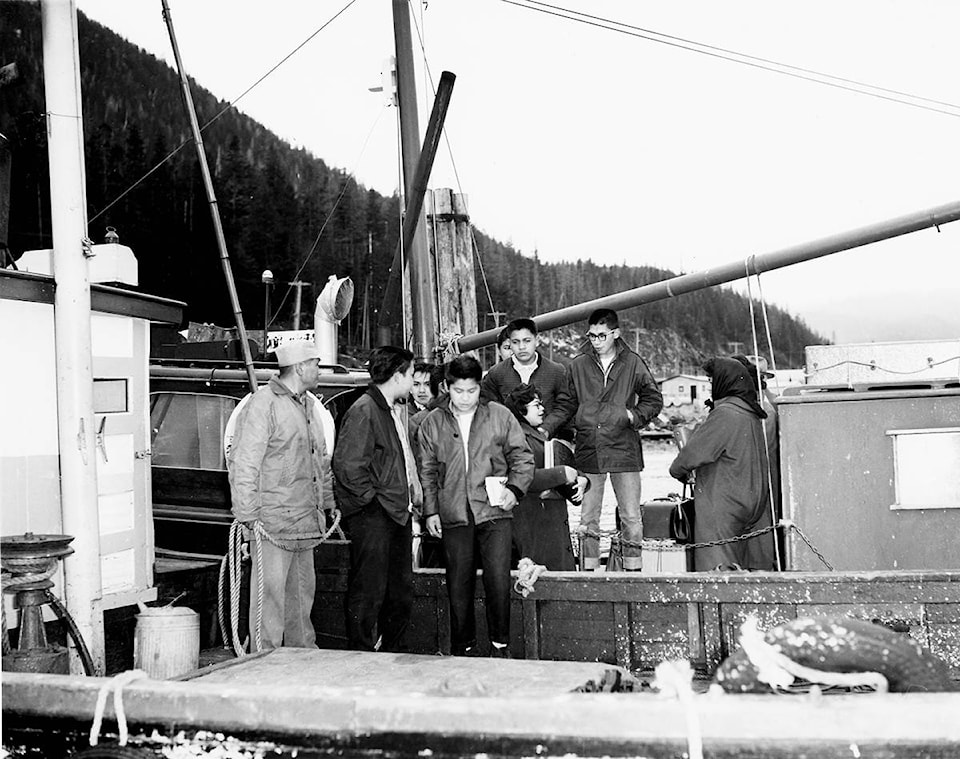By Walter Thorne
With the arrival of Alcan in 1952 and the development of the Smeltersite community there now existed two communities on opposite sides of the great, cold expanse of water – the Douglas Channel.
In the first decade, connections were made, but all transport was by watercraft. On the more isolated eastern shore, home to the Haisla, there was great interest in all that was going on the opposite shore. Before long there were Kitamaat villagers travelling across the three-plus kilometres of Kitimat Arm, landing at the Northland Navigation dock.
Some villagers also landed jobs at Alcan, which meant a daily commute. And as the months passed, there were even more reasons to cross. The modern Smeltersite Hospital was just one facility that was well-used – conveniently situated and easily accessible.
There were cultural exchanges too – music and sports were a big part of village life. Talented Haisla musicians and choirs were happy to participate in festivals, especially during the Christmas season.
Thank goodness there were some reliable vessels such as the Northern Star stationed in the village that could safely transport folk across the Kitimat Arm. Lloyd Starr remembers you could arrange a “laawees” – a trip across – on various village boats and the fare was generally twenty-five cents.
On the return voyage to the village, a few Smeltersite residents like Bud Powell would regularly hop aboard to visit Kitamaat and stay with high school chums.
By the early 1960s Haisla youth were attending classes at the new high school – Mount Elizabeth Secondary School – which made for a long day, starting with a trip across the Douglas Channel on Don Grant’s boat the Audrey G. – Don had the school board water taxi contract.
Lloyd Starr remembers that before their bus was ready for the commute into town to the high school they would get generous servings of toast and coffee from Hans and Honey, a well-respected German couple that ran a coffee shop at the Northland Navigation dock.
The lure of Kitimat was enticing, especially with the Hudson’s Bay Store.
Extracurricular school activities like basketball also meant special arrangements for crossing back to the village became necessary. Sometimes smaller dugout canoes with Johnson outboards were used to ferry folks across. Occasionally canoe trips were arranged in somewhat questionable weather conditions.
On April 17, 1962, catastrophe struck Kitamaat Village when a canoe loaded with high school students became swamped in rough seas, far out from shore – there were survivors but six Haisla youth perished.
The tragedy spurred politicians on both sides of the channel into action, determined to establish a year-round accessible road link between the two communities.
Money was budgeted by the federal and provincial governments, and by the Kitimat and Kitamaat Village councils.
Among the folk involved in getting the project going were Kitamaat’s chief councillor, Gordon Robinson (brother of current hereditary chief Sammy Robinson) and Kitimat’s mayor Sam Lindsay, provincial highways minister Phil Gaglardi, MLA Dudley Little, and Member of Parliament Frank Howard. The road politics even came up as an issue in the provincial election.
The road through challenging terrain was worked on in stages over three years. Finally, in September of 1965, the first vehicles made the crossing over the one-lane Wathl Creek bridge into Kitamaat Village.
The road, which snaked its way to the village over blasted rock and creek beds, wasn’t entirely on virgin territory – there had been a functional gravel road from the Kitimat townsite to Bert’s Boatyard at Minette Bay.
There was also a little leftover road infrastructure at the Alcan supplies depot at MK Bay which had been an operations area for the powerline construction.
Bud Powell recalled that prior to Kitamaat’s road link being completed there had only been two old pickup trucks in the Village. Within no time, following the completion of the road, villagers were purchasing vehicles. Connections meant reliable and reasonably safe trips to Kitimat stores and services, including the downtown Kitimat General Hospital – or as it later became know, the Old Pink Lady.
While the road was far from perfect, the new road link effectively ended Kitamaat Village’s physical isolation from Kitimat and provided a somewhat safe means to connect with the outside world, and all its vices and attractions.
